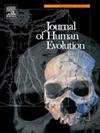Deciphering the correlated evolutionary responses of the hands and feet in modern humans
IF 3.1
1区 地球科学
Q1 ANTHROPOLOGY
引用次数: 0
Abstract
The coevolution of the hands and feet in modern humans has been a subject of significant interest due to their unique morphological features that differentiate humans from other primates and their implications in human evolution. This study aims to investigate the degree of correlated responses to selection between hands and feet and to determine whether one of the autopods has exerted a greater influence on this coevolution, focusing on their homologous elements and morphological traits. We analyzed the 38 long bones of the hands and feet from 96 modern human specimens, employing a comprehensive methodological framework that includes morphological analysis, assessments of modularity, integration, and covariation patterns under random selection. Additionally, Bayesian analyses were conducted to test whether foot morphology drives hand morphology or vice versa. Our findings indicate a high degree of morphological integration between the hands and feet, revealing a trend of increasing correlation from the first to the fifth ray. Consistent with previous studies, our Bayesian model provides robust evidence that the feet drive the morphological coevolution of human autopods, likely in response to functional selection pressures associated with bipedalism. However, our results also highlight that the intertwined evolutionary trajectories of the hands and feet are not a simple unidirectional model, underscoring the complexity of morphological integration and the diverse coevolutionary patterns among different rays, reflecting their specialized functions and evolutionary adaptations.
解读现代人类手和脚的相关进化反应。
现代人类的手和脚的共同进化一直是一个非常有趣的主题,因为它们独特的形态特征将人类与其他灵长类动物区分开来,并在人类进化中具有重要意义。本研究旨在探讨手和脚之间选择的相关响应程度,并确定其中一种自足类是否对这种共同进化产生了更大的影响,重点研究了它们的同源元件和形态特征。我们分析了来自96个现代人类标本的38块手和脚长骨,采用了一个综合的方法框架,包括形态学分析、模块化评估、整合评估和随机选择下的共变模式。此外,贝叶斯分析进行测试是否足形态驱动手形态,反之亦然。我们的研究结果表明,手和脚之间的形态高度整合,揭示了从第一到第五射线的相关性增加的趋势。与之前的研究一致,我们的贝叶斯模型提供了强有力的证据,表明足部驱动了人类自足动物的形态共同进化,可能是对与两足动物相关的功能选择压力的回应。然而,我们的研究结果也强调了手和脚交织的进化轨迹并不是一个简单的单向模型,强调了形态整合的复杂性和不同射线之间不同的共同进化模式,反映了它们的特殊功能和进化适应。
本文章由计算机程序翻译,如有差异,请以英文原文为准。
求助全文
约1分钟内获得全文
求助全文
来源期刊

Journal of Human Evolution
生物-进化生物学
CiteScore
6.30
自引率
15.60%
发文量
104
审稿时长
3 months
期刊介绍:
The Journal of Human Evolution concentrates on publishing the highest quality papers covering all aspects of human evolution. The central focus is aimed jointly at paleoanthropological work, covering human and primate fossils, and at comparative studies of living species, including both morphological and molecular evidence. These include descriptions of new discoveries, interpretative analyses of new and previously described material, and assessments of the phylogeny and paleobiology of primate species. Submissions should address issues and questions of broad interest in paleoanthropology.
 求助内容:
求助内容: 应助结果提醒方式:
应助结果提醒方式:


